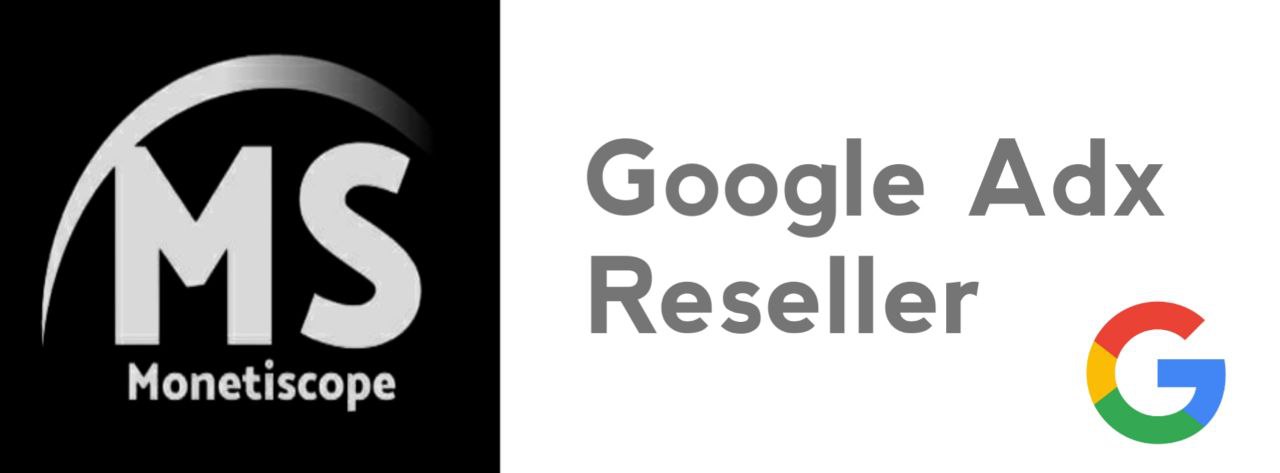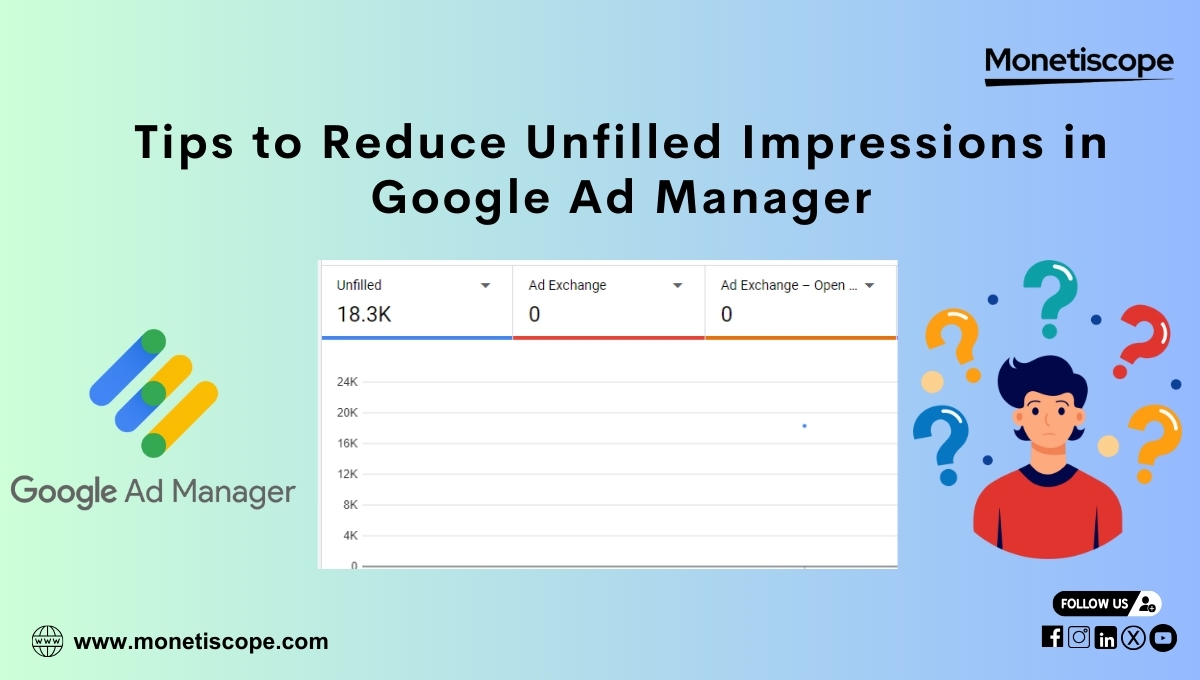If you’re managing ad inventory through Google Ad Manager and experiencing high unfilled impressions, you’re not alone. Unfilled impressions in ad manager refer to the instances where an ad request is made but no ad is served. This situation directly impacts your revenue as every unfilled ad slot represents lost potential earnings. But there’s good news—you can address this issue and improve your fill rate with the right methods and optimizations.
In this guide, we’ll explore what causes unfilled impressions, how to identify them, and most importantly, the methods and solutions to improve your fill rate effectively. We’ll cover technical adjustments, ad optimization strategies, and how partners like Monetiscope can assist in filling ad slots more efficiently.
What Are Unfilled Impressions in Ad Manager?
Unfilled impressions occur when a website sends an ad request to Google Ad Manager, but no ad is returned to fill the available inventory. This could be due to several factors—lack of demand, poor targeting, floor prices that are too high, or ad setup misconfigurations. Each unfilled impression is a lost opportunity for publishers to generate revenue.
The key metric impacted by unfilled impressions is the fill rate, which represents the percentage of ad requests that are successfully filled with ads. The goal of every publisher should be to maximize their fill rate, thereby ensuring that most of their available ad inventory is monetized.
Common Causes of High Unfilled Impressions
There are several reasons why a publisher might experience high unfilled impressions in Ad Manager. Understanding these causes can help identify solutions tailored to your unique situation.
1. Lack of Advertiser Demand
If your site caters to a niche audience or operates in a region with low advertiser demand, there may simply not be enough ad buyers bidding on your inventory, leading to unfilled impressions.
2. High Floor Prices
Setting the floor price too high can deter advertisers from bidding on your inventory. If they see that the minimum bid required is beyond their budget, they may skip your ad space altogether, resulting in unfilled impressions.
3. Geographic Mismatches
Advertisers often target specific regions. If your audience includes visitors from regions that advertisers aren’t targeting, your ad slots may remain unfilled.
4. Poor Ad Targeting
Improper targeting settings can lead to unfilled impressions. If you’re targeting too narrowly (for example, by demographic, device, or interest), fewer ads may be served because the pool of advertisers bidding on those targets is smaller.
5. Inventory Mismatch
Sometimes, the format or size of your ad units doesn’t match the types of ads that advertisers are offering, especially if you’re using less common sizes or placements.
6. Slow Page Load Times
Ads are less likely to be served if your page load time is slow. If the page takes too long to load, ad requests may timeout, leading to unfilled impressions.
7. Technical Misconfigurations
Incorrect ad setup, such as misconfigured ad tags or issues with your ad server, can result in a failure to display ads. These misconfigurations can cause unfilled impressions even when advertiser demand is high.
Methods and Solutions to Improve Fill Rate
Here’s a step-by-step guide on how to improve your fill rate and reduce unfilled impressions in Google Ad Manager.
1. Partner with Multiple Ad Networks
One of the most effective ways to increase your fill rate is to work with multiple ad networks. Google AdX alone may not always provide the demand needed to fill your inventory, so partnering with additional ad networks can increase the likelihood of filling those empty ad slots. By adding networks that specialize in different types of ads, geographies, or niches, you can diversify your ad demand and reduce unfilled impressions.
2. Use Google’s Open Bidding
Open Bidding allows multiple ad networks to compete for your ad inventory in real time, increasing the chances of getting your ad slots filled. By enabling open bidding in Google Ad Manager, you allow more advertisers to bid on your inventory, which can increase your fill rate and overall revenue.
3. Implement Header Bidding
Header bidding is a powerful technique that enables publishers to send their ad inventory to multiple demand sources at once before making a final decision. This helps in maximizing competition and improving your fill rate. By leveraging header bidding, you allow more advertisers to bid on your inventory in real time, ensuring that fewer impressions go unfilled.
4. Adjust Your Floor Prices
Setting your floor prices too high can lead to unfilled impressions in Ad Manager because many advertisers may choose not to bid on your ad slots. To solve this, experiment with lowering your floor prices or setting dynamic floor prices. This allows you to find the sweet spot where you still earn a competitive CPM while increasing your fill rate.
5. Enable Auto-Optimization Features
Google Ad Manager offers a variety of auto-optimization tools that can help you automatically adjust settings like pricing and ad targeting. Features such as Optimized Competition or Smart Bidding adjust your pricing based on demand, which can help in minimizing unfilled impressions by ensuring your floor prices are competitive.
6. Use Passback Tags
When an ad slot goes unfilled, a passback tag can send that request to another ad network or a different ad source. This ensures that you don’t lose the opportunity to monetize that impression. Passback tags can be a fallback solution to maximize fill rate, even when your primary ad server fails to provide an ad.
7. Broaden Your Targeting
Sometimes, narrowing your ad targeting too much can result in fewer ads being served. Consider broadening your targeting settings—especially geographic and device-based targeting. This allows more advertisers to bid on your inventory, increasing the chances of filling your ad slots.
8. Monitor Ad Size and Placement
Ensure that your ad unit sizes are standard and in demand. Ad units like 300×250, 728×90, and 160×600 are commonly requested by advertisers. If you use unique or less common ad sizes, you may find it harder to fill inventory. Additionally, review your ad placements to ensure they’re positioned optimally on the page for both viewability and demand.
9. Improve Page Load Speed
Slow page load times can negatively affect your fill rate because ads may time out before they have a chance to load. Optimize your website for speed by reducing file sizes, leveraging browser caching, and using content delivery networks (CDNs). The faster your pages load, the higher the likelihood that ads will be served.
10. Utilize Caching and Lazy Loading
Use lazy loading for your ads, especially for units further down the page. This means ads won’t be requested until a user scrolls down to that part of the page, reducing unnecessary ad requests that could result in unfilled impressions. Similarly, cache your website’s content to reduce page load times and improve overall user experience.
How Monetiscope Can Help
Monetiscope specializes in helping publishers optimize their ad management and reduce unfilled impressions. Our team provides personalized support, offering solutions such as header bidding, open bidding, and floor price optimization. By working with Monetiscope, publishers can increase their fill rate, ensure ad slots are consistently filled, and maximize their revenue potential.
Conclusion:
High unfilled impressions in Google Ad Manager can be frustrating, but with the right strategies and solutions, publishers can improve their fill rates and maximize their revenue. Whether it’s leveraging header bidding, optimizing floor prices, or ensuring proper targeting, there are numerous methods to increase your ad fill rate. Partnering with a specialized service like Monetiscope can further enhance your efforts, ensuring your ad slots are filled and your revenue grows.
FAQs
What is an unfilled impression?
An unfilled impression occurs when an ad request is made, but no ad is served to fill the available inventory.
How does fill rate impact revenue?
A low fill rate means many ad requests go unanswered, resulting in lost revenue opportunities. The higher the fill rate, the more of your inventory is monetized.
Why are unfilled impressions so high?
Unfilled impressions can occur due to lack of demand, misconfigured targeting, slow page load times, or high floor prices.
How can header bidding improve my fill rate?
Header bidding allows multiple ad networks to bid on your inventory simultaneously, increasing competition and the likelihood of filling your ad slots.
What are floor prices, and how do they affect fill rate?
Floor prices are the minimum amount you’re willing to accept for an ad impression. Setting them too high can result in fewer advertisers bidding on your inventory, leading to unfilled impressions.
What is open bidding, and how does it work?
Open bidding allows multiple demand partners to compete for your ad inventory, helping to improve fill rates and overall ad performance.
How does slow page load speed affect ad fill rate?
Slow page load times can cause ad requests to time out, resulting in fewer ads being served and an overall lower fill rate.
How can Monetiscope help me reduce unfilled impressions?
Monetiscope offers expertise in ad management, helping publishers optimize their ad setup and increase fill rates through strategies like open bidding, header bidding, and floor price optimization.


